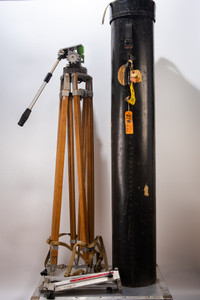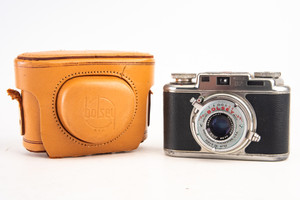This Avco Research Advanced Development high speed rotating mirror camera model MC-300 comes in its original wooden case. The camera has scuffing, scratching, finish loss and a few transfer marks on its exterior. We do not have the proper means to test it, therefore we are selling it as is untested. The case's lid is detached from the bottom portion (please see photo). The lid stays in place when all of the latches are secured. The lens has a very light haze inside of it, but it is free of any fungus or separation to its elements.
This antique Japanese made camera was used for all sorts of high speed streak photography testing in the aerospace, physics laboratories and manufacturing industries.
It is truly a work of art and a highly collectable piece of photographic history.
The terms streak photography and strip photography are often interchanged, though ... For the development of explosives the image of a line of sample was ... to the streak camera with repeated sampling and positioning, researchers have ...
Streak photography
Streak photography (closely related to strip photography) uses a streak camera to combine a series of essentially one-dimensional images into a two-dimensional image. The terms "streak photography" and "strip photography" are often interchanged, though some authors draw a distinction.
By removing the prism from a rotary prism camera and using a very narrow slit in place of the shutter, it is possible to take images whose exposure is essentially one dimension of spatial information recorded continuously over time. Streak records are therefore a space vs. time graphical record. The image that results allows for very precise measurement of velocities. It is also possible to capture streak records using rotating mirror technology at much faster speeds. Digital line sensors can be used for this effect as well, as can some two-dimensional sensors with a slit mask.
For the development of explosives the image of a line of sample was projected onto an arc of film via a rotating mirror. The advance of flame appeared as an oblique image on the film, from which the velocity of detonation was measured.
Motion compensation photography (also known as ballistic synchro photography or smear photography when used to image high-speed projectiles) is a form of streak photography. When the motion of the film is opposite to that of the subject with an inverting (positive) lens, and synchronized appropriately, the images show events as a function of time. Objects remaining motionless show up as streaks. This is the technique used for finish line photographs. At no time is it possible to take a still photograph that duplicates the results of a finish line photograph taken with this method. A still is a photograph in time, a streak/smear photograph is a photograph of time. When used to image high-speed projectiles the use of a slit (as in streak photography) produce very short exposure times ensuring higher image resolution. The use for high-speed projectiles means that one still image is normally produced on one roll of cine film. From this image information such as yaw or pitch can be determined. Because of its measurement of time variations in velocity will also be shown by lateral distortions of the image.
By combining this technique with a diffracted wavefront of light, as by a knife-edge, it is possible to take photographs of phase perturbations within a homogeneous medium. For example, it is possible to capture shockwaves of bullets and other high-speed objects. See, for example, shadowgraph and schlieren photography.
In December 2011, a research group at MIT reported a combined implementation of the laser (stroboscopic) and streak camera applications to capture images of a repetitive event that can be reassembled to create a trillion-frame-per-second video. This rate of image acquisition, which enables the capture of images of moving photons, is possible by the use of the streak camera to collect each field of view rapidly in narrow single streak images. Illuminating a scene with a laser that emits pulses of light every 13 nanoseconds, synchronized to the streak camera with repeated sampling and positioning, researchers have demonstrated collection of one-dimensional data which can be computationally compiled into a two-dimensional video. Although this approach is limited by time resolution to repeatable events, stationary applications such as medical ultrasound or industrial material analysis are possibilities.
This antique Japanese made camera was used for all sorts of high speed streak photography testing in the aerospace, physics laboratories and manufacturing industries.
It is truly a work of art and a highly collectable piece of photographic history.
The terms streak photography and strip photography are often interchanged, though ... For the development of explosives the image of a line of sample was ... to the streak camera with repeated sampling and positioning, researchers have ...
Streak photography
Streak photography (closely related to strip photography) uses a streak camera to combine a series of essentially one-dimensional images into a two-dimensional image. The terms "streak photography" and "strip photography" are often interchanged, though some authors draw a distinction.
By removing the prism from a rotary prism camera and using a very narrow slit in place of the shutter, it is possible to take images whose exposure is essentially one dimension of spatial information recorded continuously over time. Streak records are therefore a space vs. time graphical record. The image that results allows for very precise measurement of velocities. It is also possible to capture streak records using rotating mirror technology at much faster speeds. Digital line sensors can be used for this effect as well, as can some two-dimensional sensors with a slit mask.
For the development of explosives the image of a line of sample was projected onto an arc of film via a rotating mirror. The advance of flame appeared as an oblique image on the film, from which the velocity of detonation was measured.
Motion compensation photography (also known as ballistic synchro photography or smear photography when used to image high-speed projectiles) is a form of streak photography. When the motion of the film is opposite to that of the subject with an inverting (positive) lens, and synchronized appropriately, the images show events as a function of time. Objects remaining motionless show up as streaks. This is the technique used for finish line photographs. At no time is it possible to take a still photograph that duplicates the results of a finish line photograph taken with this method. A still is a photograph in time, a streak/smear photograph is a photograph of time. When used to image high-speed projectiles the use of a slit (as in streak photography) produce very short exposure times ensuring higher image resolution. The use for high-speed projectiles means that one still image is normally produced on one roll of cine film. From this image information such as yaw or pitch can be determined. Because of its measurement of time variations in velocity will also be shown by lateral distortions of the image.
By combining this technique with a diffracted wavefront of light, as by a knife-edge, it is possible to take photographs of phase perturbations within a homogeneous medium. For example, it is possible to capture shockwaves of bullets and other high-speed objects. See, for example, shadowgraph and schlieren photography.
In December 2011, a research group at MIT reported a combined implementation of the laser (stroboscopic) and streak camera applications to capture images of a repetitive event that can be reassembled to create a trillion-frame-per-second video. This rate of image acquisition, which enables the capture of images of moving photons, is possible by the use of the streak camera to collect each field of view rapidly in narrow single streak images. Illuminating a scene with a laser that emits pulses of light every 13 nanoseconds, synchronized to the streak camera with repeated sampling and positioning, researchers have demonstrated collection of one-dimensional data which can be computationally compiled into a two-dimensional video. Although this approach is limited by time resolution to repeatable events, stationary applications such as medical ultrasound or industrial material analysis are possibilities.



















